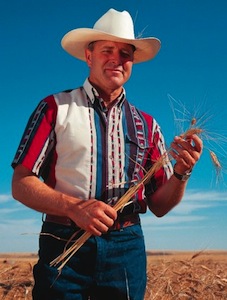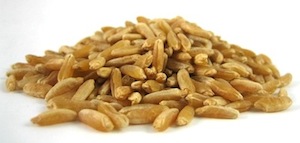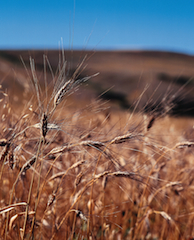(Source: Kamut International)

As demand soars across the globe, Kamut International founder Bob Quinn details how it’s the small things that have helped achieve major success. There are many versions of how KAMUT brand wheat made its way to the U.S. and into Quinn’s hands. Every good legend has its roots in folklore. The same is true for KAMUT brand wheat. But whichever of the stories touches your imagination, the simple fact is that the story of KAMUT brand wheat is more about the tenacity of a Montana farmer who had the vision of how food should be and how hard-working family farmers should be treated, than where the heirloom grain originated from.
Bob’s love of the land and growing plants are the very heart of Kamut International. As you hear him tell the story of KAMUT brand wheat you realize that the future of our food chain is in good hands.
One of the most common stories about the origins of KAMUT brand wheat is that it was descended from a handful of grain found in a stone box in a tomb near Dashur, Egypt in the 1940s. The story goes that a serviceman bought back this grain to Europe after serving in the area. While the soldier may have been told a ‘tall tale’ when it comes to the tomb—khorasan wheat was certainly grown later in the area and all of Mesopotamia.
Possibly Greek or Roman armies may have bought it over with them when they invaded Egypt. The wheat has been in Egypt for so long now that they refer to it as balady durum—the native durum of Egypt. In 1949, 36 kernels of khorasan wheat found its way to Montana and in 1977, my father, T. Mack Quinn obtained a half pint in Fort Benton that came from original grain. And the rest, as they say, is history.

Kamut International is responsible for bringing to market the 35,000 acres of organic KAMUT brand khorasan wheat currently grown in the Upper Great Plaines of the US and Canada by its group of 130 cooperative family organic farmers. It has come a long way from the original 36 grains of heirloom khorasan wheat.
When Bob Quinn and his family joined his parents in running the third-generation, 2,400-acre family farm near Big Sandy, Montana, in 1978, it was a conventional grain and cattle operation. Supporting two families on a farm that previously supported one, he needed to look for different ways to increase profits. As he began overhauling the family ranch, he established a wheat buying/brokering company in 1983, Montana Flour & Grains, in order to increase his earnings. Bob began marketing the farm’s high-quality, high-protein wheat directly to whole grain bakeries in California. When demand overtook supply, he began buying and marketing wheat from his neighbors.
In 1984 Bob started to get requests for organic grain and he became interested in finding out if organic production methods would work in North Central Montana. Always interested in growing plants and exploring new methods, his background with a PhD in plant biochemistry stood him in good stead as he began to experiment with growing his own fertilizers and eliminating herbicides and pesticides. In 1986 he plowed down 20 acres of alfalfa that had been free of chemical application for three years and planted his first certified organic crop. Within three years he had converted the whole farm to organic production. By 1991 he had one of the first 100& organically certified farms in Montana.

Organic farming is not a case of returning to old methods used before chemicals, according to Quinn, ”A lot of the old methods were not sustainable, so what I’ve tried to do is focus on understanding the whole system and have initiated a rotation system that provides weed and pest management and quality crop production.” Bob’s passion for the land and his understanding of plant chemistry, combined with his affable charm, have allowed him to market KAMUT brand wheat around the world. His many trips to food shows in Germany, Italy, France, UK, Japan and Taiwan have resulted in a small global business that is primed for substantial growth in the coming decade.
“European countries, and in particular Italy, have a real affinity for KAMUT Khorasan wheat,” comments Bob, “They have a long tradition of food preparation and appreciation passed down from generation to generation and they relate to how foods used to be. KAMUT brand wheat reminds them of the type of grains their grandparents used in their pasta making. They appreciate the high nutritional quality of KAMUT brand grain as well as the taste, it’s a very nostalgic food experience for them.”
As the demand for KAMUT brand wheat continues to grow in the US and global markets, Kamut international will expand its operations by encouraging conventional farmers to consider gradual conversion to organic methods and to incorporate KAMUT khorasan wheat into their crop rotation.
“I’m really encouraged by how well our farmers do when they move over to organic KAMUT khorasan crops. This ancient grain withstands insect infestations that often flatten whole fields of conventional wheat as well has having some resistance to drought and frost,” states Quinn.
Kamut International’s mission “to promote organic agriculture and support organic farmers” is more than just nice words. At the beginning of every season, the company sets the price for KAMUT brand grain so their partner farmers and manufacturers know exactly what they can expect for the crop for the entire year.
“Our goal is to support sustainable organic agriculture and by setting a fair and stable price so we all know what to expect,” Quinn says, “Our price is normally well above the usual fluctuations that occur in the wheat market throughout the year.
The vision that Bob Quinn had for the company from the very beginning was based on developing good, solid partnerships throughout the whole process of bringing KAMUT brand wheat to market. By working with people and letting them do what they do best Kamut International has created a model of cooperation and shared success. Our goal is to work together to solve problems when there are challenges and to all enjoy the benefits of success when things go well. From farmers, importers, distributors, millers, manufacturers and bakers, the KAMUT brand is a collective effort of dedicated individuals and companies looking to improve the quality of the foods we eat – one grain at a time.
For more information, visit Kamut International’s website.

Dear Sir
Good morning
We are looking for Khorasan Wheat 1 container to ship to south Korea.
Can you supply? if yes, please quote as best
Daniel Ohh / Lifewood Co. Ltd
Houston TX.
email: lifewood.usa@gmail.com
tel; 832-605-4890
Please contact Kamut International for your order: http://www.kamut.com